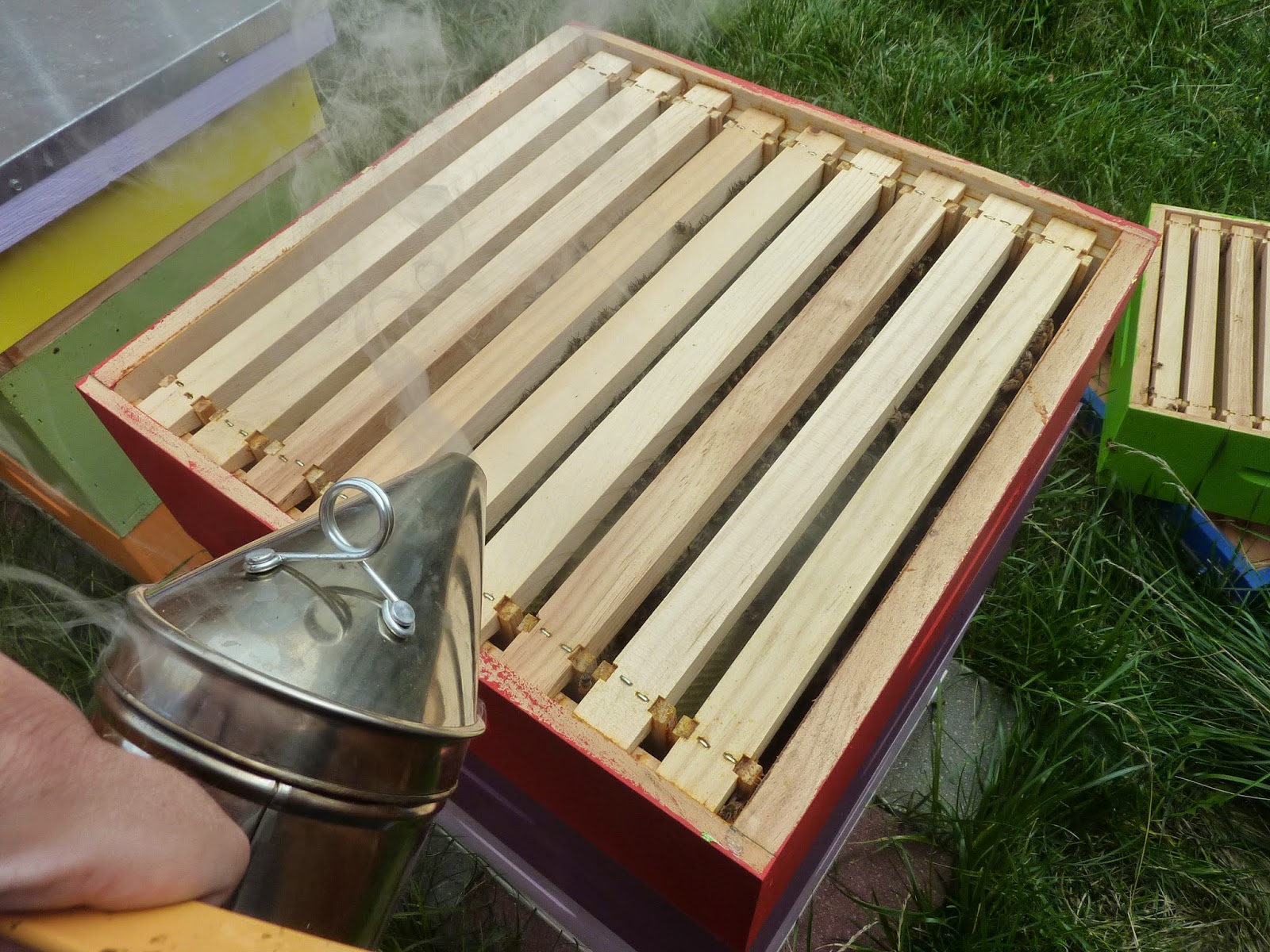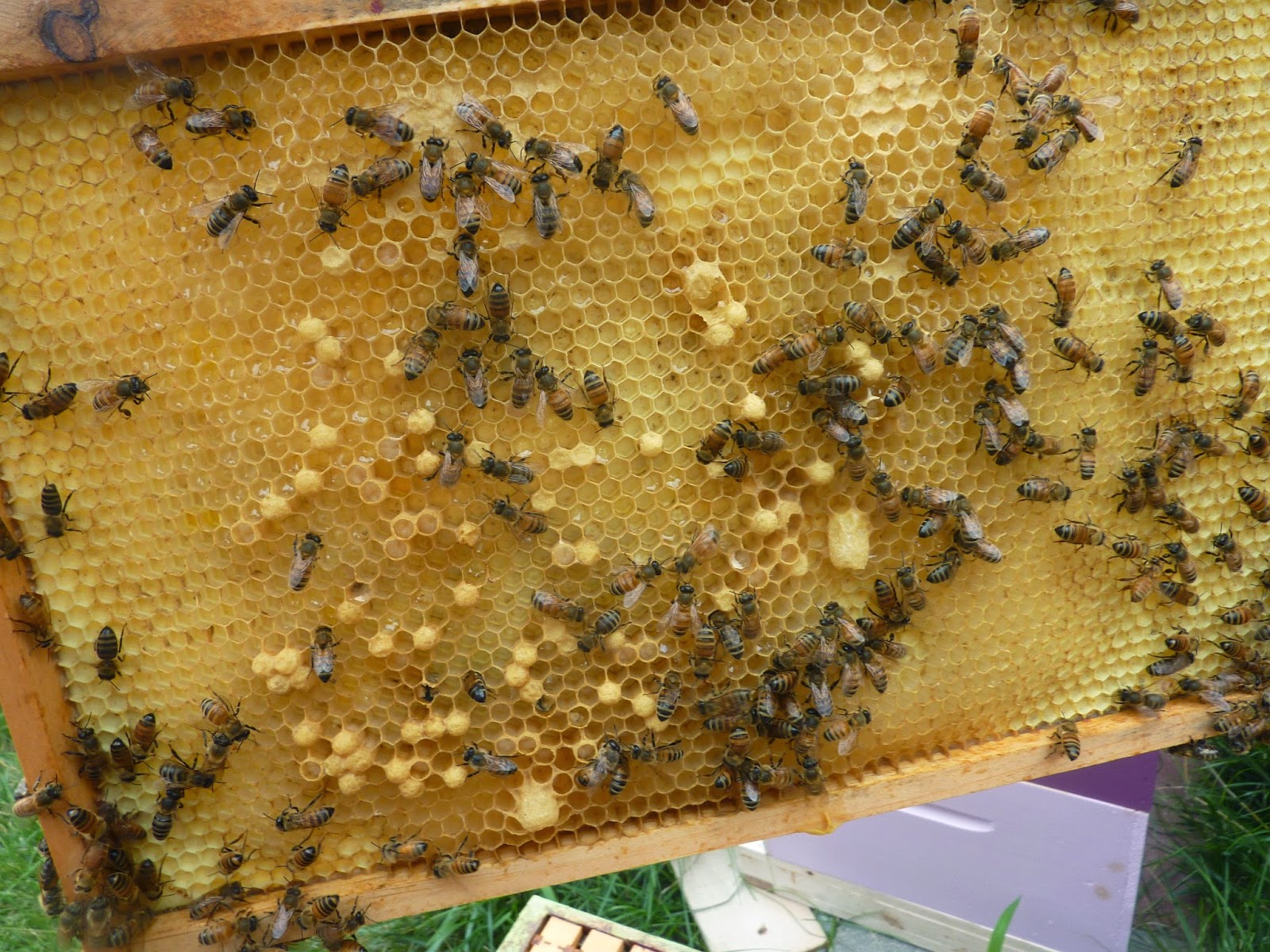Approximately two weeks after moving the frames of brood and eggs from Rose to Lavender, I opened up the hive to check on Lavender's queen raising progress. I found several queen cells, one of which was open on the end (essentially uncapped). All the others I found had been broken through the side, and some still had dead larvae inside the broken cells. After some discussion with my Dad, I learned that these were all good signs, but I hadn't found fresh eggs, which is the only guaranteed way of knowing you have a new queen. The following week, my parents happened to be coming for a visit anyway, so my Dad just said to wait another week to check them again when he was here.
August 9, 2014
We smoked Lavender, and opened it up, and my Dad immediately stated that they still didn't have a queen. He could tell by the loud buzzing sound coming from the hive. Most likely, the eggs I gave them were too old, and they couldn't raise a viable queen from any of them. While inspecting, we determined the colony wasn't using the original super that I started them in when I caught the swarm, so we removed that.
Then we smoked Rose to search for some new eggs to put another frame into Lavender and repeat the process again. However, without us realizing it, the weather began to turn cloudy and overcast. We took off the supers (the lowest super is full of honey BTW, my Dad predicted around 25 lbs!) and inspected just about every frame in the top hive body. None of the frames had anything but capped brood and honey. Before we had time to inspect the lower hive body, my Dad was stung 4 or 5 times, and we decided to close it up and come back again another day. As we closed up both hives, we moved the empty super that was on the bottom of Lavender, and put it on top of Rose, so Rose is up to 3 supers.
Within the next 2 days, we decided to order a new queen from Walter T. Kelley. We drove down to Clarkson, Kentucky on Monday, August 11, 2014 to pick it up and put the queen's cage into the hive that evening when we got back.
August 14, 2014
We inspected Lavender again to check on the queen's cage, and as soon as we opened it, the bees were much more settled than the last inspection. My Dad could tell instantly by the sound they made that they were more comfortable because they had a queen. It was a subtle change, and I wouldn't have noticed the change in their sound if he hadn't pointed it out. The workers in the hive had eaten far enough through the candy so they would have had her out by the end of that day. But we didn't want to have to go back in to remove the empty queen's cage later, because the weather was getting unpredictable. And we wanted to remove the cage as soon as possible to prevent them from building burr comb. So my Dad removed the screen from the queen's cage and released her and the attendants into the hive. I am kicking myself as I write this, because I should have taken some pictures during the last few days, especially of this task. The queen left her cage, and first climbed around on my Dad's hand before climbing down onto a frame.
At the same time, since we had the smoker burning, we checked Rose again, and the bees are actively working on the third super that we put on just 3 days before.
August 15, 2014
The bees in Rose were soooo active, I was amazed how many bees were foraging (coming in and out). My Dad predicted that the hive probably brought in at least 2 pounds of honey, just that day! Good thing we put the 3rd super on. I also was happy that we have enough fence around the hives to force the bees to fly up before flying to the flowers where they're collecting nectar, because that many bees flying in and out with a low flight pattern would make it hard for us to even be in our yard on that busy of a day.
August 16, 2014
Lavender was long over due for a refill of syrup in the feeder, and I added a 4th super to Rose. Exciting times in our backyard lately.
Still to come in the next few weeks and months:
~ Confirmation of eggs from the new queen in Lavender - it's getting late in the season, so they really need to take off fast and get to increasing their worker numbers to fill 2 hive bodies for the winter.
~ Taking supers off Rose to extract honey. I never thought this would happen the first season, but it's a whole new step for me, since I never learned this part from my Dad in person. He's coming for another short visit though, for a wedding that's a few hours away, so I am going to try to get what I can done before he gets here.
~ Winterizing - getting the hives ready for winter is important, and every beekeeper has different ideas for how to do it.
~ Assisting and mentoring a first time beekeeper




















